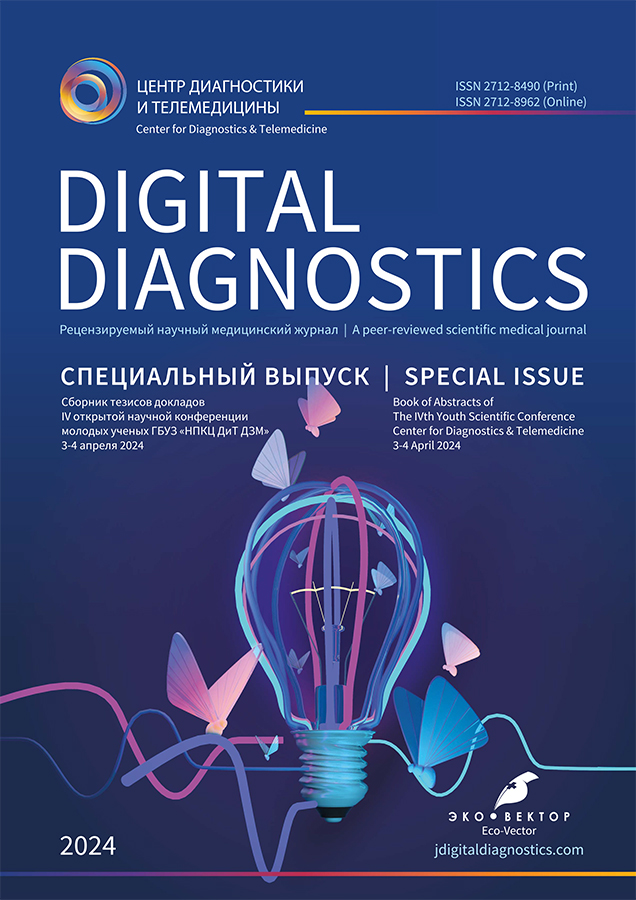Anthropomorphic abdominal aortic phantoms for computed tomography angiography
- Authors: Guseva A.V.1, Kodenko M.R.1,2
-
Affiliations:
- Bauman Moscow State Technical University
- Research and Practical Clinical Center for Diagnostics and Telemedicine Technologies
- Issue: Vol 5, No 1S (2024)
- Pages: 27-29
- Section: Articles by YOUNG SCIENTISTS
- Submitted: 13.02.2024
- Accepted: 13.03.2024
- Published: 03.07.2024
- URL: https://jdigitaldiagnostics.com/DD/article/view/626820
- DOI: https://doi.org/10.17816/DD626820
- ID: 626820
Cite item
Full Text
Abstract
BACKGROUND: Anthropomorphic vascular test objects are an important tool for improving computed tomography angiography studies, as they allow avoiding the impact of radiation exposure on the patient. The presented work is a continuation of the research in the field of development and implementation of the system of pulse blood flow simulation of vessels for computed tomography angiography studies. Based on the results of successful validation of the experimental test bench using simplified test objects [1], the work on creation of anthropomorphic test objects of the abdominal aorta imitating normal and aneurysmatically dilated vessels was initiated and carried out.
AIM: Creation of anthropomorphic test objects of the abdominal aorta from materials that simultaneously mimic the biomechanical and X-ray properties of the real vessel.
MATERIALS AND METHODS: Publicly available computed tomography data of patients were selected to create anthropomorphic test objects [2]. 3D Slicer software was used to segment studies containing normal and aneurysmatically dilated abdominal aortic lumen. The models obtained during segmentation were processed using Autodesk Meshmixer computer-aided design system. Model preparation for printing was performed using Polygon X computer-aided design system. The models were printed from water-soluble plastic using Picaso X PRO 3D printer. The resulting model was used as the basis for creating a test object using the smearing method. In order to ensure uniform thickness of the vessel wall, a structure, which is a rotating frame with adjustable speed, was developed. A combination of silicone matrix and reinforcing threads was used as a tissueimitating material with the required X-ray and biomechanical properties [3].
RESULTS: Anthropomorphic test objects were made for cases of normal and aneurysmatically dilated abdominal aortic lumen in 1:3 and 1:1 scale. A technological process of material application was developed, which made it possible to obtain a uniform layer of material over the entire volume of the model.
CONCLUSION: The results are intended for the development of computed tomography angiographyusing anthropomorphic test objects that allow taking into account the individual characteristics of the patient. Further development of the project involves testing of the obtained test objects within the framework of computed tomography angiography research using a device simulating pulse blood flow.
Full Text
BACKGROUND: Anthropomorphic vascular test objects are an important tool for improving computed tomography angiography studies, as they allow avoiding the impact of radiation exposure on the patient. The presented work is a continuation of the research in the field of development and implementation of the system of pulse blood flow simulation of vessels for computed tomography angiography studies. Based on the results of successful validation of the experimental test bench using simplified test objects [1], the work on creation of anthropomorphic test objects of the abdominal aorta imitating normal and aneurysmatically dilated vessels was initiated and carried out.
AIM: Creation of anthropomorphic test objects of the abdominal aorta from materials that simultaneously mimic the biomechanical and X-ray properties of the real vessel.
MATERIALS AND METHODS: Publicly available computed tomography data of patients were selected to create anthropomorphic test objects [2]. 3D Slicer software was used to segment studies containing normal and aneurysmatically dilated abdominal aortic lumen. The models obtained during segmentation were processed using Autodesk Meshmixer computer-aided design system. Model preparation for printing was performed using Polygon X computer-aided design system. The models were printed from water-soluble plastic using Picaso X PRO 3D printer. The resulting model was used as the basis for creating a test object using the smearing method. In order to ensure uniform thickness of the vessel wall, a structure, which is a rotating frame with adjustable speed, was developed. A combination of silicone matrix and reinforcing threads was used as a tissueimitating material with the required X-ray and biomechanical properties [3].
RESULTS: Anthropomorphic test objects were made for cases of normal and aneurysmatically dilated abdominal aortic lumen in 1:3 and 1:1 scale. A technological process of material application was developed, which made it possible to obtain a uniform layer of material over the entire volume of the model.
CONCLUSION: The results are intended for the development of computed tomography angiographyusing anthropomorphic test objects that allow taking into account the individual characteristics of the patient. Further development of the project involves testing of the obtained test objects within the framework of computed tomography angiography research using a device simulating pulse blood flow.
About the authors
Anastasia V. Guseva
Bauman Moscow State Technical University
Author for correspondence.
Email: anastas_g01@mail.ru
ORCID iD: 0009-0006-1787-4726
Russian Federation, Moscow
Maria R. Kodenko
Bauman Moscow State Technical University; Research and Practical Clinical Center for Diagnostics and Telemedicine Technologies
Email: kodenkomaria@yandex.ru
ORCID iD: 0000-0002-0166-3768
SPIN-code: 5789-0319
Russian Federation, Moscow; Moscow
References
- Kodenko MR, Guseva AV. Hydraulic circuit for pulse flow simulation in the tissue-mimicking aortic phantom. Digital Diagnostics. 2023;4(S1):35–36. EDN: SATOLX doi: 10.17816/DD430337
- MosMedData CT scan with signs of aortic aneurysm type III [Interntet]. State Budget-Funded Health Care Institution of the City of Moscow «Research and Practical Clinical Center for Diagnostics and Telemedicine Technologies of Moscow Health Care Department»; c. 2013–2023 [cited 2023 Jun 13]. Available from: https://mosmed.ai/datasets/mosmeddata-kt-s-priznakami-anevrizmyi-aortyi-tip-iii/ (In Russ)
- Kwon J, Ock J, Kim N. Mimicking the Mechanical Properties of Aortic Tissue with Pattern-Embedded 3D Printing for a Realistic Phantom. Materials. 2020;13(21):5042. doi: 10.3390/ma13215042
Supplementary files















